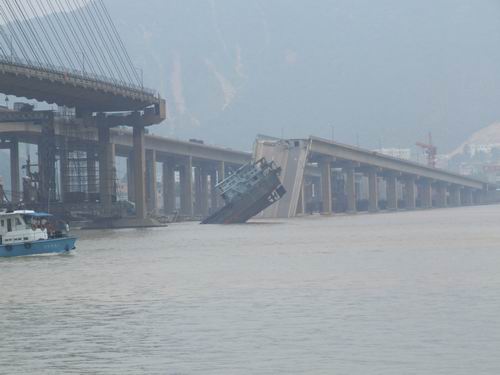美国的豆腐渣
(一)
美国的明尼苏达,号称是万湖之州(TEN THOUSAND LAKES),也因为是密西西比河的发源地,而号称是美国第一州。
和雄鸡一声天下白的中国的黑龙江省,在地理位置、气候地貌、和土壤植被方面,再没有那么相似的了。
自从中国宋代大儒朱熹的N世后代将中国大豆移植到美国的普渡大学之后,明尼苏达州,就也到处都是大豆高粮了。
既然有大豆,就有人吃豆腐。
既然有人吃豆腐,就会有豆腐渣。
这不,中国佛山的九江大桥刚塌,明尼苏达首府双城(TWIN CITY)的密西西比河大桥,就坠落水中。

2007年8月1日,美国明尼苏达州首府跨越密西西比河的I-35W公路桥梁坍塌,约30辆车落水,至少7人死亡。
2007年6月15日,中国广东佛山九江大桥坍塌,四辆汽车落水,9人失踪。
(二)
明尼苏达州的这座密西西比大桥,紧靠风景如画的明尼苏达大学的校园。

记得几年前的时候,曾经在这座桥下漫步。
这座竣工于1967年的单孔钢架拱桥,以其卓越的抗冰防寒功能闻名于世。目前明尼苏达的桥梁设计,多步其后尘。
可是为了达到破冰抗寒减压的功能,建筑师和承包商就使用了大量的胶管,也就是说,搀了大量的豆腐渣。

| • Structure ID: | NBI: 9340. |
| • Location: | River Mile 853.20. |
| • River Elevation: | 725 Feet. |
| • Highway: | I-35W. |
| • Daily Traffic Count: | 140,000 (2002). |
| • Bridge Type: | Steel Arch Deck Truss Bridge. |
| • Length: | 1,907 Feet, 458 Foot Longest Span. |
| • Width: | 8 Traffic Lanes, 108 Feet. |
| • Navigation Channel Width: | 390 Feet. |
| • Height Above Water: | 64 Feet. |
| • Date Built: | Opened November 1967. |
这才是该桥梁的致命伤。
(三)
从设计上讲,这桥完全是仿中国河北的赵州桥:

可是在材料、拱度和桥墩的处理上,则有天壤之别。
看第一张照片,明尼苏达的这座密西西比桥跨度很大,拱度却很低,桥梁所有的负荷,包括桥自身的重量,都承载于由螺丝固定住的四根水泥柱子上。这样的设计,不倒塌才怪。因为只要任何一个柱子上的螺丝给锈掉了,桥梁就有失衡和全体坍塌的危险。

后面这张照片,看的更清楚一点。

再看赵州桥,要的就是一个巧劲,桥体浑而如一,负荷都承载于两岸的地基上。只要地基不出问题,重量越大,桥体就越坚固。
(四)
看看美国的官方是如何说的:
WHITE HOUSE (AP) -- Transportation officials now say the bridge that collapsed in Minneapolis yesterday rated 50 on a scale of 100 two years ago for structural stability, and that it was classified as ''structurally deficient.'' Earlier, the White House said that rating was 50 out of 120.
意思就是,2005年的桥梁稳定性检验报告上说,该桥存在着“构造上的缺陷”按照满分100或120分来算,该桥仅得50分,不及格!
虽然她娘的交通部长还嘴硬。
Either way, Transportation Secretary Mary Peters says a rating of ''structurally deficient'' doesn't mean that the bridge is unsafe. She says it means that ''some portions of the bridge need to be scheduled for repair or replacement.''
Peters spoke after touring the collapsed bridge site. She says the bridge had been on a schedule for inspection every two years.
She's also announced a five-million-dollar grant to help pay for re-routing traffic patterns around the disaster site.

另外一份报道说,这座桥六年前就发现主桥墩和桥身固定系统有问题了:
A 2001 report by the Minnesota Department of Transportation said the bridge's deck truss system has not experienced fatigue cracking, but it has many poor fatigue details on the main truss and the floor truss system.
The report also noted fatigue problems with the bridge's approach span, but concluded fatigue cracking was not expected during the remaining useful life of the bridge. 
A two year old report from the US Department of Transportation's National Bridge Inventory database labeled the bridge as structurally deficient giving it a score of four on a scale of zero to nine.
To get a four a bridge must show signs of advanced section loss, deterioration, cracking, or scour.
(五)
下面从几张现场照片,分析密西西比和桥梁倒塌的原因。

这张照片,只能清楚地看到右边水中的两根柱子。

就是这两根柱子。

这大概是其中的一根了,柱子和钢架,完全脱离。

而对面,只有一根柱子,也就是桥墩了。

另外一个桥墩呢,原来倒掉了。

也就是这根。
结论,四个桥墩中的一个倒掉了,整个桥梁就塌落了。这一点和赵州桥的设计相比,落后了1500年。
据专家介绍,70年代以后,美国的桥梁设计,才脱离一损俱损,一荣俱荣的格局。
切!
